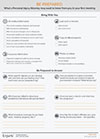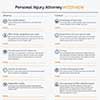Learn what actions to take if your insurance provider isn't doing its job
Insurance is your safety net—a contract made between you and your insurance company guaranteeing that, should anything happen to you, the agreed funds will be provided.
Insurance companies have the right to investigate the legitimacy of claims. However, insurers in Texas can't reject legitimate claims, misrepresent policy terms, or engage in other specific “bad acts.”
If you think your insurance company is acting unreasonably, you may need to file a bad faith claim in order to receive the compensation you deserve.
In this article, we'll talk about bad faith laws in Texas and explain what you can do to make sure your safety net does its job and catches you when you fall.
Overview of bad faith laws in Texas
In Texas, all insurance contracts have an implied covenant of good faith. This means that, even though it's not expressly stated in your policy, your insurance company is required to treat you (the “insured”) honestly and fairly.
If your insurance company breaches this implied covenant, you can sue the company for the tort of bad faith.
Proving a bad faith claim in Texas
In Texas, the insured person has the burden of proving a bad faith claim. There are 2 ways to do this:
- You can show that your insurance company denied your claim even though liability was reasonably clear, or
- You can show that the insurance company did one of the things prohibited by Chapter 541 of the Texas Insurance Code (also called the “Unfair Methods of Competition and Unfair or Deceptive Acts or Practices Act”) or Chapter 542 of the Texas Insurance Code (also called the “Unfair Claim Settlement Practices Act”).
The first option represents a “common law bad faith claim” and it has several disadvantages, including the fact that only a policyholder (not a third-party) can bring the claim (more on this later). For this reason, most attorneys prefer the second option (which is referred to as a “statutory bad faith claim”).
So what actions are prohibited by Chapters 541 and 542 of the Texas Insurance Code?
Chapters 541 and 542 prohibit an insurance company from committing “unfair or deceptive acts or practices in the business of insurance.”
This includes a host of actions outlined in the statute, such as:
- Misrepresenting a material fact or policy provision related to coverage
- Failing to attempt in good faith to reach a prompt and fair settlement when liability is reasonably clear
- Failing to promptly provide a reasonable explanation of the basis for the insurer's denial of a claim
- Failing to affirm or deny coverage within a reasonable period of time
- Refusing to pay a claim without conducting a reasonable investigation of the claim
First-party vs. third-party bad faith claims
A bad faith lawsuit can be based on a first-party claim or a third-party claim. Let's take a quick look at both of these claims.
First-party claims
A first-party claim occurs when you file a claim with your own insurance company after an accident or an injury.
For example, if your roof is damaged by hail, you would file a first-party claim with your homeowner's insurance company. If your insurance company breaches its duty of good faith by, for example, rejecting your claim without conducting an investigation, you could file a first-party bad faith lawsuit.
Third-party claims
A third-party claim involves liability insurance (a policy that you purchase in order to protect yourself from claims made by other people). A third-party bad faith claim might occur when your insurance company unreasonably fails to defend, indemnify, or settle a claim made against you.
For example, let's assume you hit another vehicle and the driver of the other vehicle files a lawsuit against you. You report the accident to your insurance company who now has a duty, under your liability policy, to defend you in the lawsuit and pay the damages (up to your policy limits). If your insurance company refuses to defend you or refuses to settle with the other driver, you would file a first-party bad faith claim. Similarly, the third-party (i.e., the victim) could file a bad faith claim against your insurance company for refusing to pay the damages.
Damages available in a bad faith claim
In general, the following damages are available in a Texas bad faith lawsuit:
- The amount of actual damages
- Court costs and reasonable attorney's fees (the court can force the insurance company to pay any attorney fees that you had to pay as a result of having to litigate the bad faith claim)
- Any other relief the court deems proper
What's more, you can recover 3 times your actual damages if you can prove that the insurer “knowingly” violated Chapter 541 of the Texas Insurance Code. This is referred to as “treble damages.”
Examples of bad faith claims in Texas
That's a lot of legalese above, we know! But let's bring in some real-world examples of how insurance companies may wrong the insured in Texas.
If any of these situations sound familiar, you may want to contact a Texas bad faith insurance lawyer.
- Your insurer denies your claim without giving a reason
- Your insurer doesn't investigate your claim
- Your insurer delays the investigation of your claim
- Your insurer fails to pay you in a reasonable amount of time
- Your insurer offers significantly less than your claim is worth
- Your insurer refuses to pay a valid claim
- Your insurer refuses to provide you with requested documentation
- Your insurer disputes a term listed in your policy
What to do if you think your insurer might be acting in bad faith
If you suspect your insurer is acting in bad faith, be sure to document all conversations with your insurance company. Make sure you save all correspondence with your insurance company and, when possible, request that your insurance company communicate with you via letter rather than phone.
As soon as possible, find a personal injury attorney who has experienced litigating bad faith claims. When you meet with the attorney for the first time, be sure to bring along a folder with all the documentation you have been keeping.
If you're not sure how to find the best attorney, read our article on choosing a Texas attorney that's right for you and consider locating one using our free online directory.
 Your First Meeting with an Attorney
Your First Meeting with an Attorney
A worksheet to prepare for your first meeting with a personal injury attorney – what to bring, what they'll ask
Download in PDF format![]()
 Personal Injury Attorney Interview Sheet
Personal Injury Attorney Interview Sheet
Worksheet with questions to ask a personal injury attorney to help determine if he or she will be a good fit for your case
Download in PDF format![]()
Did you know that bad faith insurance law varies by state?
Need a lawyer?
Hablamos español.
What does an injury lawyer do?
A personal injury lawyer helps individuals who have sustained injuries in accidents to recover financial compensation. These funds are often needed to pay for medical treatment, make up for lost wages and provide compensation for injuries suffered. Sometimes a case that seems simple at first may become more complicated. In these cases, consider hiring an experienced personal injury lawyer. Read more














